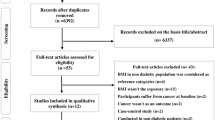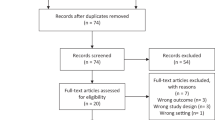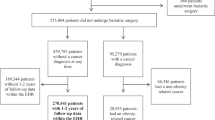Abstract
Background/Objectives:
Data regarding the relationships between body mass index (BMI) and brain tumors are inconsistent, especially for the commonly seen gliomas and meningiomas. Therefore, we conducted a dose–response meta-analysis to unravel the issue.
Subjects/Methods:
Cochrane Library, PubMed and Embase were searched for pertinent case–control and cohort studies updated to November 2014. Dose–response and quantitative analysis were conducted with random-effect model.
Results:
Sixteen studies were included, containing 3 887 156 participants and 11 614 cases. In categorical analysis for the relationships between abnormal weight and BMI, the summary risk ratio (RR) of brain tumors was 1.34 (95% confidential interval (CI), 1.15–1.56) for obesity, 1.12 (95% CI, 1.05–1.19) for overweight and 0.77 (95% CI, 0.64–0.93) for underweight; the summary RR of gliomas was 1.13 (95% CI, 1.02–1.26) for overweight and 0.71 (95% CI, 0.58–0.88) for underweight; the summary RR of meningiomas was 1.48 (95% CI, 1.30–1.69) for obesity and 1.18 (95% CI, 1.07–1.31) for overweight. In dose–response analysis, for every 5 kg/m2 increment of BMI, the summary RR was 1.13 (95% CI, 1.07–1.20) for overall brain tumors, 1.07 (95% CI, 0.97–1.19) for gliomas and 1.19 (95% CI, 1.14–1.25) for meningiomas.
Conclusions:
Excess weight was associated with increased risk of brain tumors and meningiomas but not with gliomas. Selective screening for brain tumors among obesity, especially for the females, might be more instructive.
This is a preview of subscription content, access via your institution
Access options
Subscribe to this journal
Receive 12 print issues and online access
$259.00 per year
only $21.58 per issue
Buy this article
- Purchase on Springer Link
- Instant access to full article PDF
Prices may be subject to local taxes which are calculated during checkout







Similar content being viewed by others
References
Obesity and overweight. Fact sheet No. 311. Updated August. Available at http://www.who.int/mediacentre/factsheets/fs311/en/, 2014 (accessed 26 November 2014).
Wiseman M . The second World Cancer Research Fund/American Institute for Cancer Research expert report. Food, nutrition, physical activity, and the prevention of cancer: a global perspective. Proc Nutr Soc 2008; 67: 253–256.
Kitahara CM, Platz EA, Freeman LEB, Hsing AW, Linet MS, Park Y et al. Obesity and thyroid cancer risk among U.S. men and women: a pooled analysis of five prospective studies. Cancer Epidemiol Biomarkers Prev 2011; 20: 464–472.
Lichtman MA . Obesity and the risk for a hematological malignancy: leukemia, lymphoma, or myeloma. Oncologist 2010; 15: 1083–1101.
CBTRUS. Statistical Report: Primary Brain and Central Nervous System Tumors Diagnosed in the United States in 2004-2008. Central Brain Tumor Registry of the United States: Hinsdale, IL, USA, 2012.
Reeves GK, Pirie K, Beral V, Green J, Spencer E, Bull D et al. Cancer incidence and mortality in relation to body mass index in the Million Women Study: cohort study. BMJ 2007; 335: 1134–1139.
Benson VS, Pirie K, Green J, Casabonne D, Beral V et alMillion Women Study collaborators. Lifestyle factors and primary glioma and meningioma tumours in the Million Women Study cohort. Br J Cancer 2008; 99: 185–190.
Jhawar BS, Fuchs CS, Colditz GA, Stampfer MJ . Sex steroid hormone exposures and risk for meningioma. J Neurosurg 2003; 99: 848–853.
Wiedmann M, Brunborg C, Lindemann K . Body mass index and the risk of meningioma, glioma and schwannoma in a large prospective cohort study (The HUNT Study). Br J Cancer 2013; 304: 1–6.
Johnson DR, Olson JE, Vierkant RA . Risk factors for meningioma in postmenopausal women: results from the Iowa Women’s Health Study. Neuro Oncol 2011; 13: 1011–1019.
Helseth A, Tretli S . Pre-morbid height and weight as risk factors for development of central nervous system neoplasms. Neuroepidemiology 1989; 8: 277–282.
Michaud DS, Bove G, Gallo V . Anthropometric measures, physical activity and risk of glioma and meningioma in a large prospective cohort study. Cancer Prev Res (Phila) 2011; 4: 1385–1392.
Moore SC, Rajaraman P, Dubrow R, Darefsky AS, Koebnick C, Hollenbeck A et al. Height, body mass index, and physical activity in relation to glioma risk. Cancer Res 2009; 69: 8349–8355.
Stroup DF, Berlin JA, Morton SC, Olkin I, Williamson GD, Rennie D et al. Meta-analysis of observational studies in epidemiology: a proposal for reporting. Meta-analysis of Observational Studies in Epidemiology (MOOSE) group. JAMA 2000; 283: 2008–2012.
Wells GA, Shea B, O'Connell D, Peterson J, Welch V, Losos M et al The Newcastle-Ottawa Scale (NOS) for assessing the quality of nonrandomised studies in meta-analyses. Available at http://www.ohri.ca/programs/clinical_epidemiology/oxford.asp, 2008 (accessed 23 August 2014).
World Health Organisation. Obesity: preventing and managing the global epidemic. Report of a WHO consultation. World Health Organ Tech Rep Ser 2000; 894: 1–253.
Greenland S, Longnecker MP . Methods for trend estimation from summarized dose-response data, with applications to meta-analysis. Am J Epidemiol 1992; 135: 1301–1309.
Orsini N, Bellocco R, Greenland S . Generalized least squares for trend estimation of summarized dose-response data. Stata J 2006; 6: 40–57.
Wang X, Dong Y, Qi XQ, Huang C, Hou L . Cholesterol levels and risk of hemorrhagic stroke: a systematic review and meta-analysis. Stroke 2013; 44: 1833–1839.
Higgins JP, Thompson SG, Deeks JJ, Altman DG . Measuring inconsistency in meta-analyses. BMJ 2003; 327: 557–560.
Egger M, Davey Smith G, Schneider M, Minder C . Bias in meta-analysis detected by a simple, graphical test. BMJ 1997; 315: 629–634.
Duval S, Tweedie R . Trim and fill: A simple funnel-plot-based method of testing and adjusting for publication bias in meta-analysis. Biometrics 2000; 56: 455–463.
Higgins JP, Green S, Collaboration C. Cochrane Handbook for Systematic Reviews of Interventions. Wiley Online Library, 2008. Available from http://handbook.cochrane.org/.
Edlinger M, Strohmaier S, Jonsson H, Bjørge T, Manjer J, Borena WT et al. Blood pressure and other metabolic syndrome factors and risk of brain tumour in the large population-based Me-Can cohort study. J Hypertens 2012; 30: 290–296.
Oh SW, Yoon YS, Shin SA . Effects of excess weight on cancer incidences depending on cancer sites and histologic findings among men: Korea National Health Insurance Corporation Study. J Clin Oncol 2005; 23: 4742–4754.
Samanic C, Chow WH, Gridley G, Jarvholm B, Fraumeni JF Jr . Relation of body mass index to cancer risk in 362,552 Swedish men. Cancer Causes Control 2006; 17: 901–909.
Claus EB, Calvocoressi L, Bondy ML, Wrensch M, Wiemels JL, Schildkraut JM . Exogenous hormone use, reproductive factors, and risk of intracranial meningioma in females. J Neurosurg 2013; 118: 649–656.
Custer B, Longstreth WT Jr, Phillips LE, Koepsell TD, Van Belle G . Hormonal exposures and the risk of intracranial meningioma in women: a population-based case-control study. BMC Cancer 2006; 6: 152–160.
Duan B, Hu XB, Zhao HY, Qin J, Luo J . The relationship between urinary bisphenol A levels and meningioma in Chinese adults. Int J Clin Oncol 2013; 18: 492–497.
Lee E, Grutsch J, Persky V, Glick R, Mendes J, Davis F . Association of meningioma with reproductive factors. Int J Cancer 2006; 119: 1152–1157.
Little RB, Madden MH, Thompson RC, Olson JJ, Larocca RV, Pan E et al. Anthropometric factors in relation to risk of glioma. Cancer Causes Control 2013; 24: 1025–1031.
Schildkraut JM, Calvocoressi L, Wang F, Wrensch M, Bondy ML, Wiemels JL et al. Endogenous and exogenous hormone exposure and the risk of meningioma in men. J Neurosurg 2014; 120: 820–826.
Preston-Martin S, Munir R, Chakrabarti I . Nervous system. In: Schottenfeld D, Fraumeni JF (eds), Cancer Epidemiology and Prevention, 3rd edn. Oxford University Press: New York, NY, USA, 2006, pp 1173–1195.
Louis DN, Ohgaki H, Wiestler OD, Cavenee WK, Burger PC, Jouvet A et al. The 2007 WHO classification of tumours of the central nervous system. Acta Neuropathol 2007; 114: 97–109.
Ron E, Modan B, Boice JD, Alfandary E, Stovall M, Chetrit A et al. Tumors of the brain and nervous system after radiotherapy in childhood. N Engl J Med 1988; 319: 1033–1039.
Preston-Martin S, Mack W, Henderson BE . Risk factors for gliomas and meningiomas in males in Los Angeles County. Cancer Res 1989; 49: 6137–6143.
Preston-Martin S, Pogoda JM, Schlehofer B, Blettner M, Howe GR, Ryan P et al. An international case-control study of adult glioma and meningioma: the role of head trauma. Int J Epidemiol 1998; 27: 579–586.
Schlehofer B, Blettner M, Preston-Martin S, Niehoff D, Wahrendorf J, Arslan A et al. Role of medical history in brain tumour development. Results from the international adult brain tumour study. Int J Cancer 1999; 82: 155–160.
Pergola GD, Silvestris F . Obesity as a major risk factor for cancer. J Obes 2013; 2013: 291546.
Renehan AG, Roberts DL, Dive C . Obesity and cancer: pathophysiological and biological mechanisms. Arch Physiol Biochem 2008; 114: 71–83.
McKeown-Eyssen G . Epidemiology of colorectal cancer revisited: are serum triglycerides and/or plasma glucose associated with risk? Cancer Epidemiol Biomarkers Prev 1994; 3: 687–695.
Giovannucci E . Insulin and colon cancer. Cancer Causes Control 1995; 6: 164–179.
Calle EE, Kaaks R . Overweight, obesity and cancer: epidemiological evidence and proposed mechanisms. Nat Rev Cancer 2004; 4: 579–591.
Giovannucci E . Nutrition, insulin, insulin-like growth factors and cancer. Horm Metab Res 2003; 35: 694–704.
Renehan AG, Frystyk J, Flyvbjerg A . Obesity and cancer risk: the role of the insulin–IGF axis. Trends Endocrinol Metab 2006; 17: 328–336.
Kaaks R, Lukanova A, Kurzer MS . Obesity, endogenous hormones, and endometrial cancer risk: a synthetic review. Cancer Epidemiol Biomarkers Prev 2002; 11: 1531–1543.
Basen-Engquist K, Chang M . Obesity and cancer risk: recent review and evidence. Curr Oncol Rep 2011; 13: 71–76.
Roberts DL, Dive C, Renehan AG . Biological mechanisms linking obesity and cancer risk: new perspectives. Annu Rev Med 2010; 61: 301–316.
Shao C, Bai LP, Qi ZY, Hui GZ, Wang Z . Overweight, obesity and meningioma risk: a meta-analysis. PLoS One 2014; 9: e90167.
Acknowledgements
Foundation from the National Natural Science Fund of China (81371382) for LH and Science and Technology of Commission of Shanghai Municipality (14430721300) for YD.
Author information
Authors and Affiliations
Corresponding author
Ethics declarations
Competing interests
The authors declare no conflict of interest.
Additional information
Supplementary Information accompanies this paper on European Journal of Clinical Nutrition website
Rights and permissions
About this article
Cite this article
Zhang, D., Chen, J., Wang, J. et al. Body mass index and risk of brain tumors: a systematic review and dose–response meta-analysis. Eur J Clin Nutr 70, 757–765 (2016). https://doi.org/10.1038/ejcn.2016.4
Received:
Revised:
Accepted:
Published:
Issue Date:
DOI: https://doi.org/10.1038/ejcn.2016.4
This article is cited by
-
Risk of central nervous system tumour incidence in a cohort of workers chronically exposed to ionising radiation
Radiation and Environmental Biophysics (2024)
-
Extracellular lipid loading augments hypoxic paracrine signaling and promotes glioma angiogenesis and macrophage infiltration
Journal of Experimental & Clinical Cancer Research (2019)
-
Comparative analysis of intracranial meningiomas in patients younger than 40 years
Journal of Neuro-Oncology (2019)
-
Allergic conditions and risk of glioma and meningioma in the CERENAT case-control study
Journal of Neuro-Oncology (2018)



